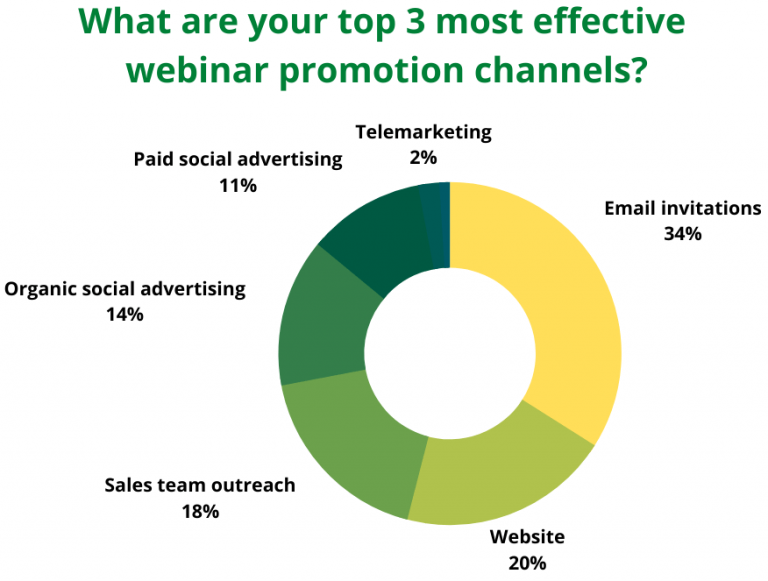Webinars are a popular way for businesses to make meaningful connections with their audience. But, without a strategy to increase audience engagement, a webinar can quickly become a boring event that no one remembers.
Successful webinars use a variety of engagement tools to keep their audience attentive. These include Q&A sessions, interactive quizzes, and screen sharing. When your audience is engaged, they’re more likely to retain what you said and look to your brand in the future.
In this guide, we’ll show you how to create a webinar engagement strategy to increase engagement before, during, and after your event. Let’s dive in.
Skip ahead:
- Why is webinar engagement important?
- 10 techniques to increase and sustain webinar engagement
- Make your virtual events a success with webinar engagement
Why is webinar engagement important?
Webinar engagement is an important part of your customer engagement strategy that can make or break your online events.
Engaging webinars leave a lasting impression on your audience and help to build an emotional connection with them. They’re then more likely to engage with your business in the future. They may also tell others about their positive experiences, increasing brand awareness.
What’s more, by sustaining engagement after the webinar, you can strengthen the connections with your target audience. Engagement features like polls are also a great way to learn more about them. You can use this information to inform your marketing strategy.
10 techniques to increase and sustain webinar engagement
A webinar engagement strategy should increase engagement before and during the webinar and sustain that engagement afterward. With this in mind, here are ten webinar engagement techniques you can use to make your webinar a success.
How to increase engagement before the webinar
To hold a successful online event, you must first choose a webinar topic that resonates with your target audience. Then, you need to prepare your webinar content and carry out some technical checks. For instance, if you plan to use your smartphone, make sure you know how to conference call on Android or iOS.
Once you’ve finished your preparations, it’s time to engage your audience. The following strategies can help you promote your webinar to a larger audience and generate anticipation.

Image sourced from influno.com
-
Advertise on social media
Social media is a great place to advertise your upcoming events, including webinars. For example, you can create an event hashtag and share a teaser clip to get people talking about your webinar. You can also answer audience questions about the event or hold a quick poll on Facebook or X (formerly Twitter) to see who your event appeals to. You could even use some of your marketing budget to run a paid advert.
You can use social media AI to automate the process of scheduling and publishing posts to save time and reach more people.
-
Hold a pre-webinar survey
A pre-webinar survey serves two purposes. First, it lets you learn about your target audience so you can make your webinar even more useful and appealing. Second, it lets your audience make their voices heard. It shows you care about their opinions, which is vital for building trust.
Ask your audience three or four questions about their expectations and needs. For instance, say you’re a B2B company holding a webinar on how to choose the best VoIP (Voice over Internet Protocol) software. You could ask questions like:
- What is your current level of experience with VoIP software?
- What specific pain points or challenges do you hope the webinar will address?
- What are your business goals in relation to VoIP software?
-
Create a landing page on your website
Finally, it’s important to create an engaging landing page for the webinar on your website. This is the place where you can direct people to register for the event. This can be created as an extra page on your website using a solution like WordPress, Thinkific, or WebFlow. You can also create single-page websites as landing pages using platforms like Zoho, Hubspot, or Envato. Many of these have landing page templates or no-code solutions to simplify the process for you.
Your registration form should be short. Many people struggle with a lack of time, so a lengthy sign-up process will put them off. Also, collect their email address so you can send them a reminder email and give them more information.
Your landing page should tell people about the topics you’ll cover and include a short bio for each speaker. You could also consider a conversational AI platform for your website to answer any questions people have, including about the webinar.
 Image created by writer statistic sourced from statista.com
Image created by writer statistic sourced from statista.com
How to increase engagement during the webinar
Engagement strategies during the webinar help you maximize audience attention and interest. Interactive webinars are the most engaging, and there are several ways to use interactive elements in your event. We’ve outlined these below.
-
Include a call to action (CTA)
The best automated webinar platforms let you add interactive features, including calls to action. A CTA is a great way to encourage future engagement with your brand. Depending on the purpose of your webinar, your CTA could be:
- Scheduling a product demo.
- Signing up for a free trial.
- Subscribing to your mailing list.
- Entering a contest or giveaway.
- Downloading a free ebook or guide.
- Registering for an online course.
Make sure your CTA is relevant and aligns with your business goals. Also, be sure to tell people the value of your offering when you ask them to take action (without sounding too promotional).
-
Incorporate a fun quiz or poll
Audience distraction is a common problem, especially in a long webinar. A fun quiz or poll can help you re-engage your audience and break up your presentation. They’re simple to design, too, if your webinar platform or marketing platform has a polling feature.
As well as being engaging, quizzes and polls let you check your audience’s understanding. For instance, you could have a quiz at the beginning to gauge your audience’s existing level of expertise. You could then have another one halfway through to check if they’re retaining everything.
You could also have a poll at the end of the webinar to see which topics people want to learn more about. Then, incorporate this into your post-webinar engagement marketing.
-
End with a Q&A session
Many webinars only have one-way communication: the speaker talks, and the audience listens. To enhance engagement, it’s important to promote two-way communication. Q&A sessions are ideal for this.

Image sourced from financesonline.com
In a Q&A session, instead of talking to your audience, you can talk with them. You can invite them to ask questions and ask them questions in return.
Your audience will feel involved, and they can enhance their understanding of the topic and get more out of the experience. At the same time, you can get ideas for future sessions and learn more about your target audience.
-
Show, don’t tell
Another way to increase engagement is to show participants how to do something rather than just talk about it.
For example, say your webinar explains a process or a piece of software, such as how to set up an online conference session or how to use your app’s new features. Your audience will understand the process much better if they can see it via a screen share.
Screen sharing lets your audience view your screen in real-time, so they can see exactly how to do something. You can even give a participant temporary control over your screen to try out the process themself.
How to sustain engagement after the webinar
Post-webinar engagement strategies sustain interest in your brand and help convert webinar attendees into loyal customers. Here are three strategies you can use to build on the success of your webinar.
-
Send follow-up emails
Email is still a popular form of communication, and it’s ideal for promoting your webinar. It’s equally important, though, to create an effective email marketing strategy to engage your audience after the webinar.
Your email marketing campaign should be relevant to your audience and deliver value. For instance, your post-webinar emails could include:
- A link to the recording of the webinar
- Information about future events on related topics
- Key takeaways from the presentation
- Links to relevant articles on your blog
- A short recap quiz
You could also ask attendees to rate your webinar, contact your sales team, or share their experience on social media.
 Image sourced from founderjar.com
Image sourced from founderjar.com
-
Provide complementary resources
You could also provide links to complementary resources like ebooks, videos, case studies, and how-to guides to give further value to your audience. As an example, say your webinar was about the benefits of using a hybrid integration platform for digital transformation. Complementary resources could include:
- A guide on how to choose a hybrid integration platform
- An ebook that explains hybrid cloud integration in detail
- A video demonstration of your hybrid integration software
Complementary resources help to keep your audience engaged and interested in your brand. You can also showcase your expertise and establish yourself as a reliable source of information, building trust.
-
Hold a post-webinar survey
Lastly, send out a post-webinar survey to evaluate the success of your webinar and pinpoint areas for improvement. A survey also shows your audience that you care about their opinions, which helps to build loyalty. Ask questions like:
- How likely are you to recommend the webinar to a friend?
- In your opinion, what was the most interesting/informative part of the webinar?
- What could we have done to improve the webinar?
- Overall, how satisfied were you with your experience?
Use the data you collect to inform your future webinars and refine your engagement strategy.
 Free to use image sourced from Unsplash
Free to use image sourced from Unsplash
Make your virtual events a success with webinar engagement
Webinars are critical tools in today’s digital age. They help you build an authentic connection with your audience, but only if they’re engaging.
An engaged audience is more likely to remember your webinar presentation and tell others about their experience. They’re also more likely to seek further engagement opportunities with your brand.
The right engagement strategies can boost conversions and brand awareness before, during, and after your webinar.
First, you can promote your webinar to different audience segments and build anticipation. Next, you can encourage participation during your webinar to create personal connections and add interest. Finally, you can create a tailored follow-up strategy to keep your brand in your audience’s minds and turn them into loyal customers.





